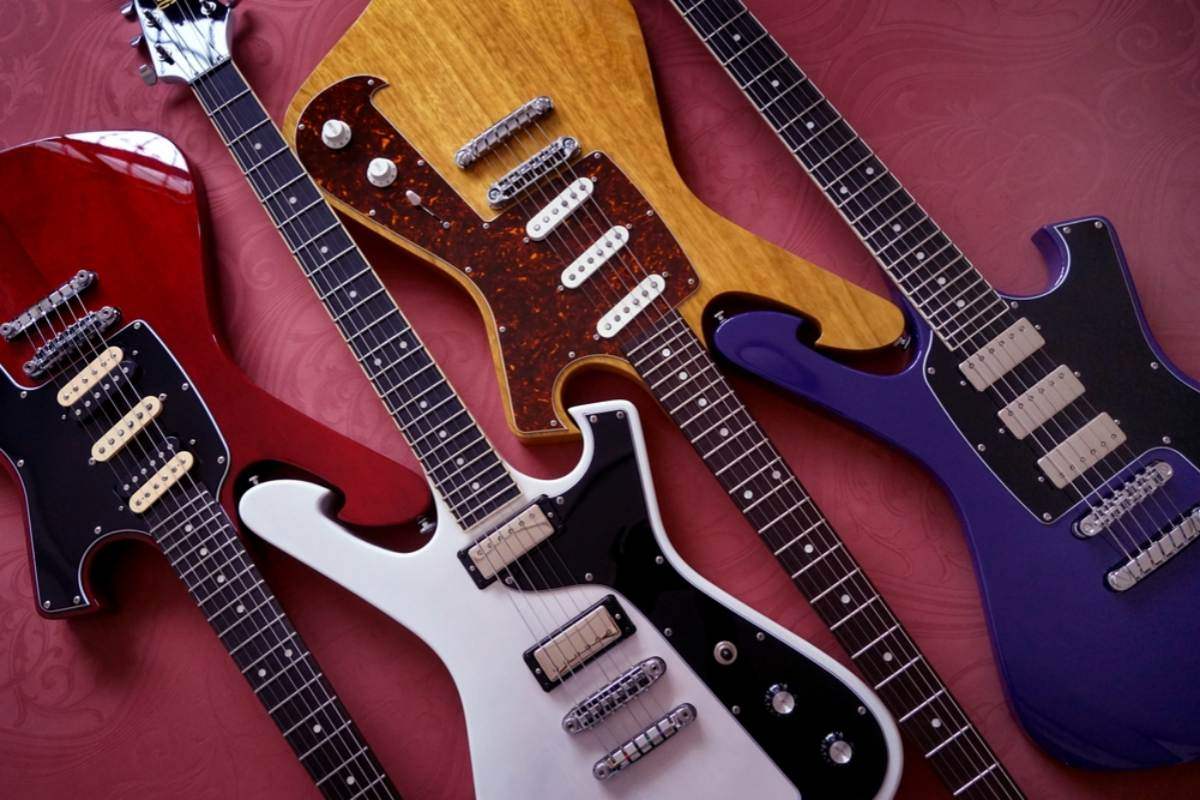Guitars aren’t complicated devices, but they do need a thing or two to stay in tune for a full song. One of the main components of that equation is the bridge. But that’s only half the story because bridges also affect tone and your ability to express through the instrument.
In this piece, I’ll dissect the types of guitar bridges so you can make an informed decision when buying or upgrading.
Are you ready? Because this is a one-way ticket to solving all your bridge-related questions in a single spot.
Learn more about guitar bridges with us.
Types of Guitar Bridges
There is a plethora of different types of guitar bridges in the market today. Yet, that was not always the case. On the contrary, each era of guitar playing was marked by the type of guitar used by the mainstream players and what those instruments could offer.
But before we dive right into the world of guitar bridges, let’s make a very important distinction between tremolos and bridges.
Guitar Bridge vs Tremolo System
To talk about guitar bridge types and tremolo systems is, sometimes, to talk about different things.
A guitar bridge is a must. You can’t play a bridgeless guitar; strings need to go from tuning pegs to bridge with no exception. That said, your guitar might or might not have a tremolo system.
The tremolo will add the ability to change the pitch of a given note. With it, you can mimic the natural vibrato of a player’s hands or go full-on Van Halen or Dimebag Darrell and create a style around it.
Now that this difference is clear, let’s address each type of bridge and tremolo system.
Types of Electric Guitar Bridges
Let’s look at some electric guitar bridge types and some tremolo systems.
Wraparound Bridge
The wraparound, invented by Gibson in 1953 to replace the big trapeze bridge big jazz guitars had, is a type of electric guitar bridge. It’s a single bar with dedicated string slots. Its name comes from the way you load the strings that go in from the front and wrap around the bridge to then go all the way to the nut.
The only adjustable part of this bridge is string height. That said, it’s not an obsolete guitar part, brands like PRS and Gibson continue to use it to this day.
How Does It Sound?
The words to describe this bridge’s sound are spanking, raw, and rocking. It doesn’t have a great deal of sustain, but mids and mid-high frequencies come alive. I have one in my SG Jr., and it’s part of my instrument’s raw bite.

Tune-O-Matic Bridge
Another Gibson invention, this bridge came out in 1953 and is what Les Paul guitars feature. The difference between a wraparound and a tune-o-matic is quite big. For starters, you can adjust the intonation on each string. Secondly, strings go from the bridge to a stop tail bar forming an angle that enhances sustain. Finally, strings don’t wrap anywhere but are loaded through the stop tail bar.
How Does It Sound?
If you’ve been listening to Les-Paul-driven music, you’ll know they’re famous for their sustain. Well, part of that sustain also comes from the tune-o-matic bridge. For chunky tones and larger-than-life sustain, a tune-o-matic bridge is the perfect option.

Roller Bridges
Mainly known as their most famous brand, Bigsby, this is the first tremolo system I’ll tell you about. The idea is that strings wrap around a bar that you can then move by pushing or pulling a spring-loaded tremolo arm. This is a great tremolo unit to mimic natural player vibrato or add subtle touches here and there. Also, it’s the only tremolo system you can install in an archtop guitar.
How Does It Sound?
Gretsch guitars are well-known for being Bigsby-equipped instruments. There isn’t much of a tone change because the system includes a tune-o-matic style bridge.

Telecaster-style Bridges
In 1952, Leo Fender revolutionized the world of guitars forever. The Telecaster was his first design, and the bridge is unique in many senses. Perhaps, the most revolutionary aspect is that it allowed players to adjust string height in pairs (modern ones allow single-string adjustments) instead of lifting or lowering the entire bridge.
How Does It Sound?
Much of what we know as the Telecaster “twang” and its trademark high-frequency spank comes from its bridge. The particularity is that the strings go through the guitar and the bridge is completely attached to the body, so it’s a spanking guitar with lots of resonance and moderate sustain.

Stratocaster “Synchronized Tremolo” System
In 1954, Leo did it again with, arguably, the best-selling guitar shape in modern history. The synchronized tremolo, upon release, was miles ahead of all the competition. This system works with springs loaded below the pickguard that bring the tremolo back to its position and keep the guitar in tune. But that’s not all, this bridge also allows intonation and height adjustment per string.
Plus, we all know what players like Hendrix, Jeff Beck, and many others did with it pushing music boundaries further, right?
How Does It Sound?
The Synchronized tremolo is a bottom-loader. Strings go through a big block of metal that’s underneath the bridge. This, and the fact that the bridge is attached to the body by six springs or two pivots, gives this tremolo system a good balance between sustain and tone-changing possibilities.

Fender Offset Tremolo Systems
If you’ve ever played a Jazzmaster or a Jaguar, you’ll know they have one of the best tremolo systems in the world. It’s easy to use, feels musical, and that long tremolo arm is handy. Also, Mustangs have a great tremolo system that I love using with my pinky wrapped around the tail bar.
Although the Jazzmaster tremolo system is amazing, the bridge is, at least, controversial to most players. The good news is that replacements aren’t hard to find.
How Does It Sound?
Because of the tune-o-matic bridge before the tremolo system and the big offset body, these guitars tend to have a good balance of sustain and usability.

Double-locking Tremolo Systems
The eighties redefined the music landscape in ways the guitar-making world wasn’t ready for. Eddie Van Halen and his Frankenstein guitar (now hanging at the prestigious MET) are proof of that. Perhaps, the best-known brand is Floyd Rose, named after its founder, who got his first patent in 1979.
This tremolo system locks the string at the bridge (you have to cut the ball end and tighten them with an Allen wrench) and at the nut. This translates into the ability to do a dive-bomb effect, AKA, leave the strings completely floppy and go back to perfect tuning. Also, if it’s floating and the guitar is carved, you can go up with the pitch as well (here’s Dimebag doing it).
The con of the floating systems is that the bridge is kept in place by the strings, therefore, if you break one, your guitar goes completely out of tune immediately.
How Does It Sound?
Tone purists claim this kind of tremolo system has a big impact on sustain. While that is arguably true, it also broadens your moves catalog a lot. Furthermore, most virtuoso players (Vai, Satriani, Petrucci) play with one of these to mesmerize audiences around the world.
Guitar Bridges and Intonation
Before wrapping this piece up, let me tell you that your bridge plays a big role in intonation. To clear it up, a perfectly intonated guitar sounds in perfect pitch when strings are played open or fretted anywhere on the neck.
To adjust this, you need to shorten or lengthen each string, so if your guitar sounds out of tune when you fret it and is perfectly in tune when you check it with open strings, it needs intonation adjustments.
Wraparound bridges don’t offer this capability, but all the other types of bridges and tremolos named above do.
Guitar Bridges and String Action
String action is as particular as the fingerprint or the color of the eyes. Every bridge named above offers the ability to lower or raise the guitar’s string. The ones that allow per-string action adjustments are the Strat, Tele, and Floyd tremolo systems.
So, if you want to make more precise adjustments, then you should aim for one of those. If you’re not so picky, any of the above will do.
Electric Guitar Bridges and Expression
The electric guitar bridge types and tremolo systems will affect the tone of your instrument but also the number of moves you can perform. So, if you consider yourself somewhat of a purist, fixed bridges and tune-o-matics offer the highest sustain levels while Floyd Rose and other tremolo systems offer the highest maneuverability.
The Bottom End
When choosing a guitar bridge or tremolo system, most of us stick with what comes standard in our guitar. Yet, that’s not the only approach, because we can talk about legendary players like Eddie Van Halen who refused to take no for an answer and changed the history of rock music on the way.
So, if any of the above sounds like a solution to a current problem, guitar saddles, bridges and tailpieces and tremolos could be what you need to take your playing to the next level. Get a replacement before changing your guitar bridge.
Happy (tremolo-abusing) playing!
If you like this article, please share it!
Be sure to join our FB Group Guyker Guitar Parts & Accessories Community to share your ideas! You can also have connections with like-minded guitar players, Guyker updates as well as discounts information from our FB Group.





